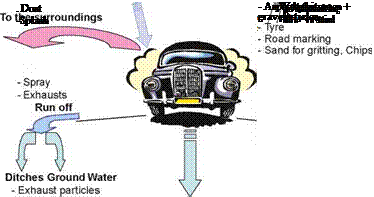Context
Roads and road traffic influence the natural environment in a complex manner. At the same time as roads serve the transport of people and goods, roads take land and form barriers to the movement of people, animals and water in the landscape. A range of pollutants is emitted from roads and traffic and spread to the environment.
The pollutants are transferred away from the road mainly via road-surface runoff and aerial transport but also with percolation through the pavement. Runoff pollution is a much studied issue whereas much less is known about pollutants percolating through the pavement and embankment into the groundwater and surface waters.
The vast majority of the pollutants stay close to the road where they accumulate in vegetation, soil and also animals. To some extent, pollutants are transported further away mainly by aerial transport but also by water movement. In ecosystems receiving traffic pollutants, various ecosystem compartments and ecological processes will be affected.
 |
Water is one of the most important transport media for the pollutants. Soil and water are the main targets of the pollutants (Fig. 6.1). Man, animals and plants are dependent on water of good quality, and legislation typically puts much emphasis on the protection of groundwater and surface water. Given the dense road network and rapidly increasing traffic, protecting the environment from road and traffic pollutants and securing a good water quality is an area of increasing concern to road planners and engineers.
Fig. 6.1 Sources and routes of contaminants in the road environment. Reproduced by permission of the Swedish Road Administration
This chapter is devoted to sources, transport pathways and targets of road and traffic pollutants, as introduced in Chapter 1 (see Section 1.6 and Fig. 1.7). The domain dealt with is confined to the area vertically limited by the pavement surface and the groundwater table, and laterally by the outer drainage ditch at each side of the road (see Fig. 2.1). Pollutant sources such as traffic, cargoes, pavement and maintenance are briefly described. Knowledge of pathways and transport processes is important for the understanding of pollutant appearance in saturated or unsaturated porous media, and consequently for the understanding of effects on ecosystems and their compartments. Following a discussion of these issues, a concluding section briefly refers to EU legislation pertaining to the protection of waters as a natural resource, and the role of roads and traffic in that connection.






Leave a reply